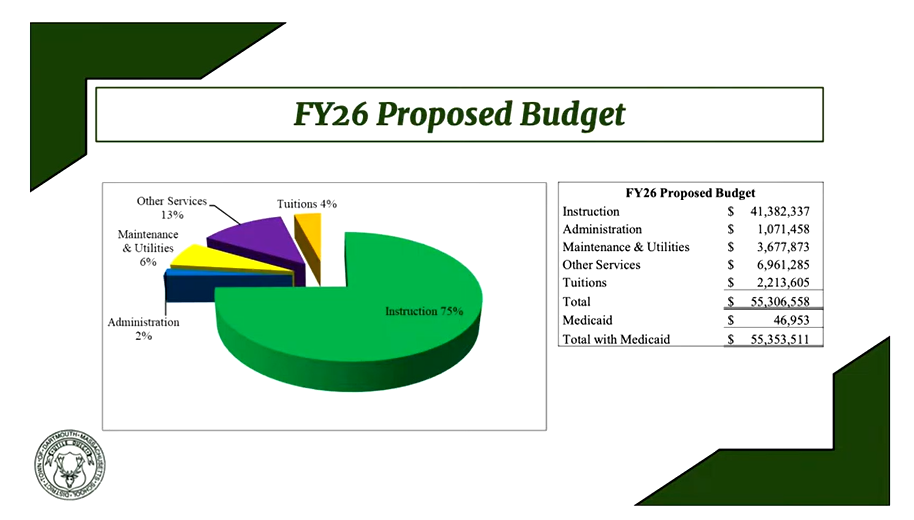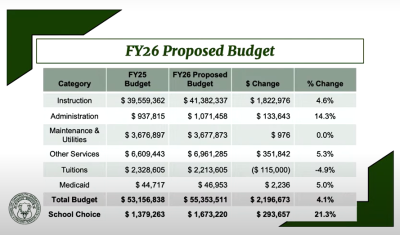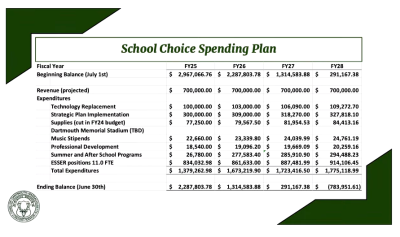School Committee works to finalize its Fiscal Year 2026 budget
The Dartmouth School Committee is projecting a 4.1% increase to its Fiscal Year 2026 budget, which they are still working to finalize.
At its Monday, Feb. 10 meeting, the committee discussed its plans to finance the budget, which is projected to cost $55,353,511, and its increases, focusing primarily on the use of school choice funds, which had supplemented the budget’s deficit last fiscal year. However, the proposed solution is not sustainable long term and the committee continues to consider its options.
School choice funds, which come from a program that allows out-of-district students to attend the high school and are contingent on a yearly vote, would fund $1,673,220 worth of expenses, including the salaries of 11 employees, curriculum materials and technology replacements, said Assistant Superintendent James Kiely.
“I personally never thought we would be there,” he added. “It’s significant.”
As current projections stand, the district won’t have enough school choice funds to cover expenses beyond Fiscal Year 2027.
At the beginning of Fiscal Year 2026, the district is projecting to have $2.2 million in the school choice involvement account, and after using almost $1 million in reserves through the budget plan, the district would be left at the start of Fiscal Year 2027 with approximately $1.3 million in school choice funds, Kiely said.
Based on the current trend, the district is projected to spend a little over $1.7 million in Fiscal Year 2027 with school choice funds, ending the year with a little under $300,000 remaining in the account.
“Obviously that is where it ends,” Kiely said. “We no longer would have the funding necessary to continue that for another year.”
Committee member John Nunes commented on the school choice funds, saying, “The way I look at this, we’re out of money in ’28, so we have two years to get our act together.”
He added that school choice should be handling incidentals and extras, such as purchasing a box of paper clips or pens rather than salaries.
Dartmouth Public Schools are also $2,752 below the state average in total spending per-pupil. This is most notable in operations and maintenance as well as insurance and benefits, which are both nearly 40% below the state average, and in administration spending, which is 33% lower than the average, Kiely said.
To make the Fiscal Year 2026 budget recommendations work, the district would have to make “significant decisions” in terms of the reallocation of resources, Kiely said.
This could include getting rid of seven job positions, with the potential for nine, through attrition and reallocating the finances to support the district’s recommendations. With the proposed addition of 11 jobs, this would ultimately reduce staffing by two positions.
In an effort to cut costs, Kiely is also working to reduce the bus route in Fiscal Year 2026, citing the fact that it costs $80,000 per bus route with costs increasing in this area.
The school district has less staff per 100 students than the state average in every category, as well as compared to schools with similar demographics as Dartmouth.
The student body has also undergone some changes in the past few years with enrollment projected to be a bit lower than it’s been. Over the last 10 years, Dartmouth has also seen an increase in its percentage of high needs students increasing from 29% to 43%, low income students increasing from 17.5% to 30%, and students with disabilities increasing from 12.5% to over 21%, according to Kiely.
“Our students are continuing to become a needier population year after year,” he said.
He added that these are important factors to consider when talking about the resources they need to support kids.
“We are not asking for all the pretty little things,” said member Kathleen Amaral. “These are the things we need for our school district to function.”














